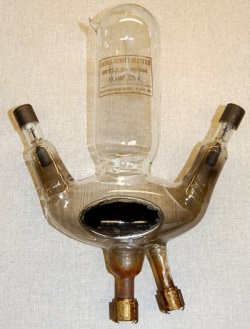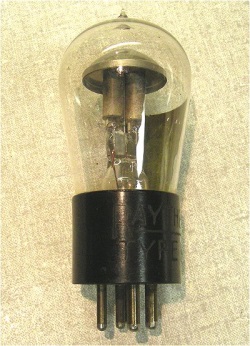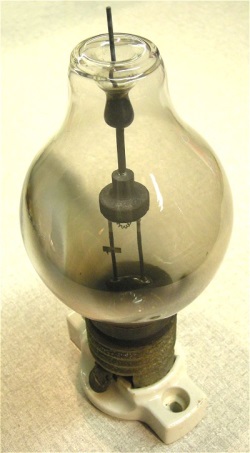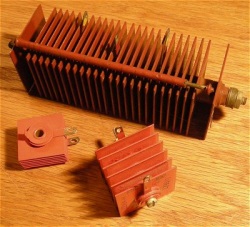BY STEVE JOHNSON ()
Converting ac to dc has been accomplished by several different types of rectifiers through the years. Here are a few of the more common types of rectifiers used in the past 100 years.

A Cooper Hewitt Rectifier sold by GE around 1921.
Mercury arc rectifiers
Mercury arc rectifiers, also known as “Cooper Hewitt Rectifiers” were used in the early 20th century before the use of semiconductors to convert alternating current to direct current in high-voltage and -current applications. Constructed of glass for low-power applications and steel tanks for higher-power applications, Mercury Arc rectifiers work on the principle that an arc of electricity between an anode and a pool of mercury will only pass current in one direction. It was not uncommon to have a glass mercury arc rectifier with several anodes for higher-power applications that resembled a large glass octopus.
Today these large odd-shaped tubes are sought after by vacuum tube collectors. Unfortunately since they contain mercury, they are considered hazardous material and should not be shipped by common carrier or the U.S. Mail. The large amount of liquid mercury in these rectifiers has lead to many of them being recycled, further reducing the number that turn up for collectors. Today expect to pay $50 to $150 for a two anode rectifier and several hundred dollars for mercury arc rectifiers with more than two anodes. It's not very likely, but if you are looking to add one to a collection, you might find one in your local area, so proper packing and shipping won't be a concern and additional cost.
The Raytheon BH vacuum tube rectifier
In the second half of the 1920s, Raytheon developed the BH rectifier tube. Its primary purpose was to supply enough power to convert the new household 110-V ac current from a lighting circuit into the two or three different voltages needed to replace the costly batteries in most early battery powered home radios. Containing two cathodes in fireproof sleeves, the BH tube was able to supply enough power in a package the size of a standard radio tube without frequent burn out. The BH rectifier tube also had a consistent voltage drop, which meant the associated power supply circuits needed less filtering and voltage regulation.

A Raytheon BH Tube Rectifier.
The BH tube was used extensively in radio battery eliminators through the second half of the 1920s. A BH tube is easily recognized by its mushroom-shaped anode inside the top of the tube.

Typical construction of a BH tube rectifier.
Since the BH tube was primarily used in battery eliminators and not the radio itself, the BH tube is harder to find. The current demand for the BH tube is primarily for use in restoring a 1920s battery eliminator or as a display item in a vacuum tube collection. Even though these are less common, they usually sell for $10 to $25 in good working condition.
Tungar bulbs
Tungar bulbs were half-wave rectifiers and commonly used in battery chargers, carbon-arc lamps, early high-power speaker systems, and other industrial applications. The “Tungar” name is derived from the tungsten filament and argon gas used in these early rectifiers. The term “bulb” most likely comes from the large-diameter screw-type base many had.

The Tungar bulb rectifier
Tungar bulbs were still used up to the 1970s in stage lighting. Today they are easy to find, so their value is not great. Typical prices range from $25 to $40 for nice collector examples with their original porcelain sockets, but Tungar bulbs in working condition may sometimes be found for as little as $15 to $20.
The Number 80 vacuum tube
The 80 vacuum tube is a full-wave rectifier. This type of four-pin glass rectifier tube appeared around 1926. Like the BH tube, the 80's early development was driven by the implementation of electricity in the home and increasing demand for home radios that could run off the new ac electric light wiring.

A common #80 vacuum tube.
The 80 was most commonly used in home radios and tube amplifiers in the 1930s. Different manufactures numbered their 80 as 280, UX280 and other numbers. This was the most common type of rectifier vacuum tube and was used in millions of radios up to the 1940s, when it was replaced by updated versions based on the same design. Today an unused (new-old stock) or tested number 80 vacuum tube sells for between $12 and $25.
Selenium rectifiers
One of the more interesting rectifiers was used after World War II. Developed in the 1930s, the selenium rectifier contained a stack of several steel or aluminum plates coated with bismuth or nickel, with a thicker layer of selenium and a halogen element added. Each plate could typically withstand 20 to 22 reverse volts and the voltage rating was easily increased by adding additional plates to the stack at the time of production. Selenium rectifiers were more efficient than vacuum tubes but unfortunately, they had a shorter usable lifespan and could not be easily replaced by the end user. By the 1970s they were replaced by the smaller, more efficient and reliable silicon diode, which was much cheaper to manufacture.

Selenium Rectifiers voltage rating was increased by adding plates.
Selenium rectifiers today have little or no value to a collector or equipment restorer. I have seen selenium rectifiers rebuilt by inserting a diode inside to maintain the original look but most restorers and service technicians today simply replace them with a modern rectifier.
For more information and examples of early electronic technology view my collection at StevesAntiqueTechnology.com
Related Products: Diodes, Transistors, and Thyristors
Advertisement
Learn more about Electronic Products Magazine





